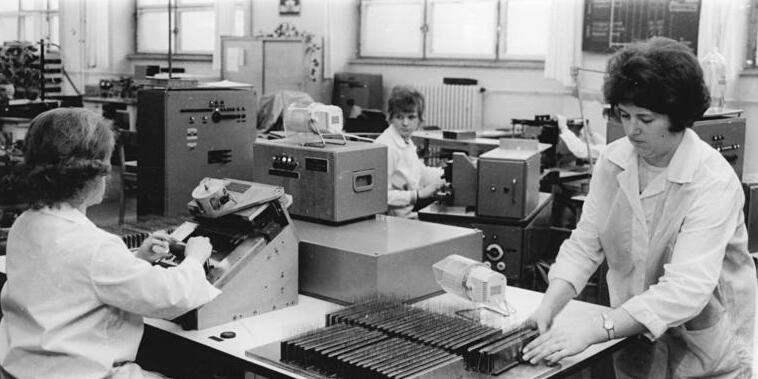
[ad_1]
When the sclerotic political and economic system of the German Democratic Republic (GDR) collapsed in November 1989 after the fall of the Berlin Wall, the full speed economic transformation towards the market system of West Germany led to unprecedented disruptions on all levels of society and the economy. Only a few months earlier in August 1989, the then General Secretary of the Socialist Unity Party of Germany (SED), Erich Honecker, introduced the first 32-bit CPU computer chip made in East Germany and optimistically said, ‘the course of socialism won’t be stopped neither by ox nor donkey’. But neither Honecker nor the 32-bit chip had a long future ahead of them: Honecker, whose forced retirement in October 1989 accelerated the end of ‘really existing socialism’, died in 1994; the 32-bit chip didn’t even find its way into serial production.
Economic crash
The accelerated development of computer chips, semiconductors and further microelectronic components in the GDR started at the end of the 1970s. The central committee of the SED decided to heavily invest in the development and production of microelectronics to modernize the industrial sector of the planned economy. This very ambitious programme tried to close the productivity gap not only in the electronics sector but also in other industrial branches. It aimed to improve production technology at a time when microelectronics was already boosting American and Western European economies. The GDR political elite’s goal seemed reasonable because its economy suffered from a lack of workforce and often from aged machinery.
It would have been considerably cheaper to import this technology than to start a full development process. However, due to a CoCOM (Coordinating Committee for Multilateral Export Controls) technology embargo, initiated by the US in 1950, the GDR and other member states of the Comecon (Council for Mutual Economic Assistance) had no access to high-quality computer chips. High-cost proprietary development was the only option to access this type of technology. Despite enormous financial investment, the GDR never managed to reach world market standards. In 1989, a decade after the programme began, the unit prices of GDR-produced chips clearly exceeded world market prices: while a 265KB chip in the GDR cost 534 marks, the world market price of a comparable chip was just 17 marks; and the GDR’s market share of global electronic production shrank from 0.8 to 0.4 % in the 1980s. Gerhard Schürer, Head of the State Planning Commission, summed up the effort to produce 40-60% of the world market product line of computer chips as ‘commercial madness’.
As long as internal use and protected export into other Comecon states was possible, this commercial madness didn’t manifest in the balance sheets. But, as soon as East Germany became part of the Federal Republic of Germany (FRG) during unification in 1990, its economy was forced to open and became part of the European Economic Area (EEA). Suddenly, it was part of the global economy without protective tariffs or other measures that could have eased the shock waves caused by the transition from a planned to an increasingly deregulated market economy.
And these shock waves were enormous. The transformation of Eastern Germany and its economy represented a significant structural break that led to enormous consequences on all levels of the economic system. Deindustrialization significantly affected employment: 3,300,000 industrial workplaces reduced to only 660,000 in 1994. Overall employment in Eastern Germany fell from nearly 10 to 6.5 million (1989-1992) and the recorded rate of unemployment rocketed from zero to 20%. Formerly lifelong jobs became suddenly insecure and by the end of 1992 only one in two East Germans still worked for the same company as before 1989.
Firms crash
Looking at firms and their employees provides a vivid picture of the dimension of this transformation process. One very illustrative case is the former VEB Werk für Fernsehelektronik (WF) in East Berlin. As a part of the huge GDR-Kombinat Mikroelektronik Erfurt, the WF produced various types of vacuum and electron tubes, semiconductor parts and further microelectronic components. In 1989 it was the largest industrial company in East Berlin. In 1990 the WF was reorganized as a private limited company under full ownership of the national privatization agency Treuhandanstalt.
Just a couple of months after the fall of the Berlin Wall yet before the formal unification in October 1990, several thousand workers were laid off; the WF had lost its market share in Eastern Europe to new competitors on the open global electronic market. The quantities per product the WF had produced in the Comecon era were not price competitive on the global market. By 1992 the number of employees was cut by almost 90%: from approximately 9,000 to around 1,000. Most parts of the WF were shut down. Only the colour picture tube production site survived as a larger unit, because it was sold, with the help of large subsidies, to Samsung. The large Korean corporation continued to produce these tubes in Berlin until 2005 when the technology was superseded by LCD and Plasma displays. Instead of investing large sums into developing new equipment once again in Berlin, Samsung transferred its production of TV sets in Europe to Hungary, benefiting from lower wage costs.
Individual crash
These mass layoffs produced enormous difficulties for WF workers who had up to that point enjoyed very stable jobs within a large and holistically caretaking firm. Prior to economic collapse, they had expected to remain in these reliable positions until their retirement. The constitution of the GDR stipulated a right to work and workforce demand was high, partly due to a constant drain of personnel to the West, partly because of inefficient, labour-intensive production technology. GDR firms guaranteed lifelong careers and provided additional services that were socially requested but not necessary for the firm’s existence such as housing for its workers, childcare, healthcare and other public services. However, as soon as the new private owners started to reduce the duties of the company and the number of employees to the most profitable amount, the WF workers experienced what had not existed in the former GDR: unemployment.
Those fired were overnight forced to ‘bring their labour-power to market for sale as a commodity’. But the labour market that emerged had very limited absorbing capacities, because mass layoffs affected a large number of Eastern German companies. In Berlin the number of registered jobseekers grew from 0 to 196,100 in just two years (1991), increasing to 383,200 in 2004.

VEB Werk für Fernsehelektronik workers, 1971. Image from German Federal Archive via Wikimedia Commons
Given this tight labour market, it is highly understandable that many older WF workers made use of early retirement offers, whenever possible. For younger, well-trained, male workers, certain job options opened up. The job market was more difficult for the middle age group, who were too young for early retirement but often too old for the few remaining jobs. Women were particular badly affected. Samsung, for example, announced a job offer in 1993 in the Berliner Zeitung searching for a ‘male workforce up to 35 years of age … to start immediately’.
Crash courses in market economy
For a small number of former WF engineers, starting their own businesses appeared to be a more promising option than unemployment, even if it was rather a last resort than an opportunity they had dreamed of. They stated in recent qualitative interviews that their main goal was ‘to keep the research going and make use of the know how’ that had been developed in their WF departments rather than become rich and successful businessmen. These former department heads also felt responsible for keeping their co-workers in employment. In one of these business projects, 7 out of 10 founding members, formerly WF employees, had marriage partners who were also affected by sudden unemployment when the business was founded in 1990.
Aside from the one large privatization deal to Samsung, more than a dozen Management-Buy-Out initiatives established small businesses with initially 5 to 40 employees, of which several are still in business today. In 1999 Silicon Sensor, one of these new companies, even mastered an initial public offer on the Frankfurt Stock Exchange.
These entrepreneurial successes shouldn’t be taken for granted given the launch conditions these WF engineers and scientists had to handle in 1990. Firstly, they owned no significant private capital to invest in their business projects. Accumulation of private capital wasn’t an important goal as the possibilities to use it were quite limited. Instead, they relied almost exclusively on bank loans and public subsidies. These loans were hard won, as banks were cautious when it came to lending money to people without commercial market economy experience. And public subsidies were often tied to additional funding from banks. So, these entrepreneurs, out of necessity, had to convince each funding partner that the others were already aboard, even though they often weren’t yet.
Secondly, no equipment, machinery nor commercial property was available at the start. Although remaining WF buildings could initially be rented for 1-3 years, this wasn’t a relief since banks usually asked for long term rental contracts before they granted investment credits. Equipment was mostly bought second hand directly from WF leftovers or was improvised. One project, for example, built its clean-room structures partly from IKEA kitchen furniture decades before the Swedish furniture dealer discovered businesses as an important customer group. A talent for making the best out of very little, acquired in the socialist economy of shortage in the GDR paired with a do-it-yourself mentality and a modest lifestyle, helped to start businesses in adverse conditions.
The new entrepreneurs also had to learn how business is done in a capitalist market society. They had to swiftly develop an ‘economic habitus’, because 30 years of life in a ‘soviet’ regime had left traces through dispositions, mental habits and interests. The French sociologist Pierre Bourdieu, in his studies of the Kabylia in Algeria during the 1960s, described a ‘mismatch between economic dispositions fashioned in a precapitalist economy and the economic cosmos imported and imposed, oftentimes in the most brutal way, by colonization.’ Not by accident has the integration of East Germany into the structures of West Germany been described by several authors as a form of ‘colonization’ or ‘friendly takeover’ as the legal and economic rules and norms of the Federal Republic of Germany were more or less unchanged when transferred to the expanded territory.
Former WF-employees experienced what Bourdieu in his later writings used to call ‘hysteresis’: a mismatch caused by the tendency towards persistence of the habitus and a rapidly changing field. The habitus that was developed over decades and perfectly fitted the field of a large, state-owned firm in the GDR lost its capacity to subconsciously handle many aspects of life post-1989. The situation was like that of immigrants in a new country but with the significant difference that WF-employees didn’t choose to leave their point of origin. East Germans became ‘immigrants in their own country’ and experienced an ‘unplanned change of citizenship status’ without having much time for necessary personal planning and preparation.
The interviewed entrepreneurs reported that they had no prior knowledge about marketing and sales and quickly had to acquire an understanding of a specific business behaviour. They had to learn that elegant suits and prestigious cars matter when meetings with potential customers or creditors were scheduled. Good product quality alone was not enough to fill order books anymore. One entrepreneur who held a doctorate degree in physics explained that he bought himself three business administration textbooks and read them in the evenings to acquire the necessary knowledge about cost accounting and calculation once the technical tasks of the day were completed. But the mentality of West Germans remained a greater mystery to him:
I couldn’t understand the Wessis [West Germans]. You can learn business administration, that’s not the problem. But sales – to explain something from engineer to engineer was okay, but to talk with economists and how to sell and so on, that was a problem. (Interview G1, par. 40; translation by author)
Another entrepreneur who graduated in information technology and led a WF department with more than 100 workers expressed similar difficulties:
In 1990 we started to talk with resellers and explained to them the sensors we wanted to produce. That was one of the first steps we made to get an idea of the mechanisms. You have to imagine that we didn’t know market economy from personal experience. Of course, we didn’t come from the middle of nowhere. We could read the technical literature. But the practical part of commerce, we had no clue about that. Formation of prices, bookkeeping, accounting and so on. (Interview G2, par. 60, translation by author)
East Germans had to quickly learn the rules and norms of the West German market economy and market society if they wished to continue their professional careers or start commercial projects. Economic dispositions have to be seen in their historical context, as each economic period or setting is based on different principles. A sense of play for the new playing field has to be developed. East Germans had to learn ‘the market’ and incorporate the habitus of the homo economicus – the ever-calculating man. Due to rapid German unification, this adaptation wasn’t foreseeable and needed to be accomplished without delay or a learning phase: not even a year had passed between the fall of the Berlin Wall (9 November 1989) and the unification act (3 October 1990).
This article has been published as part of the youth project Vom Wissen der Jungen. Wissenschaftskommunikation mit jungen Erwachsenen in Kriegszeiten, funded by the City of Vienna, Cultural Affairs.
Source link




